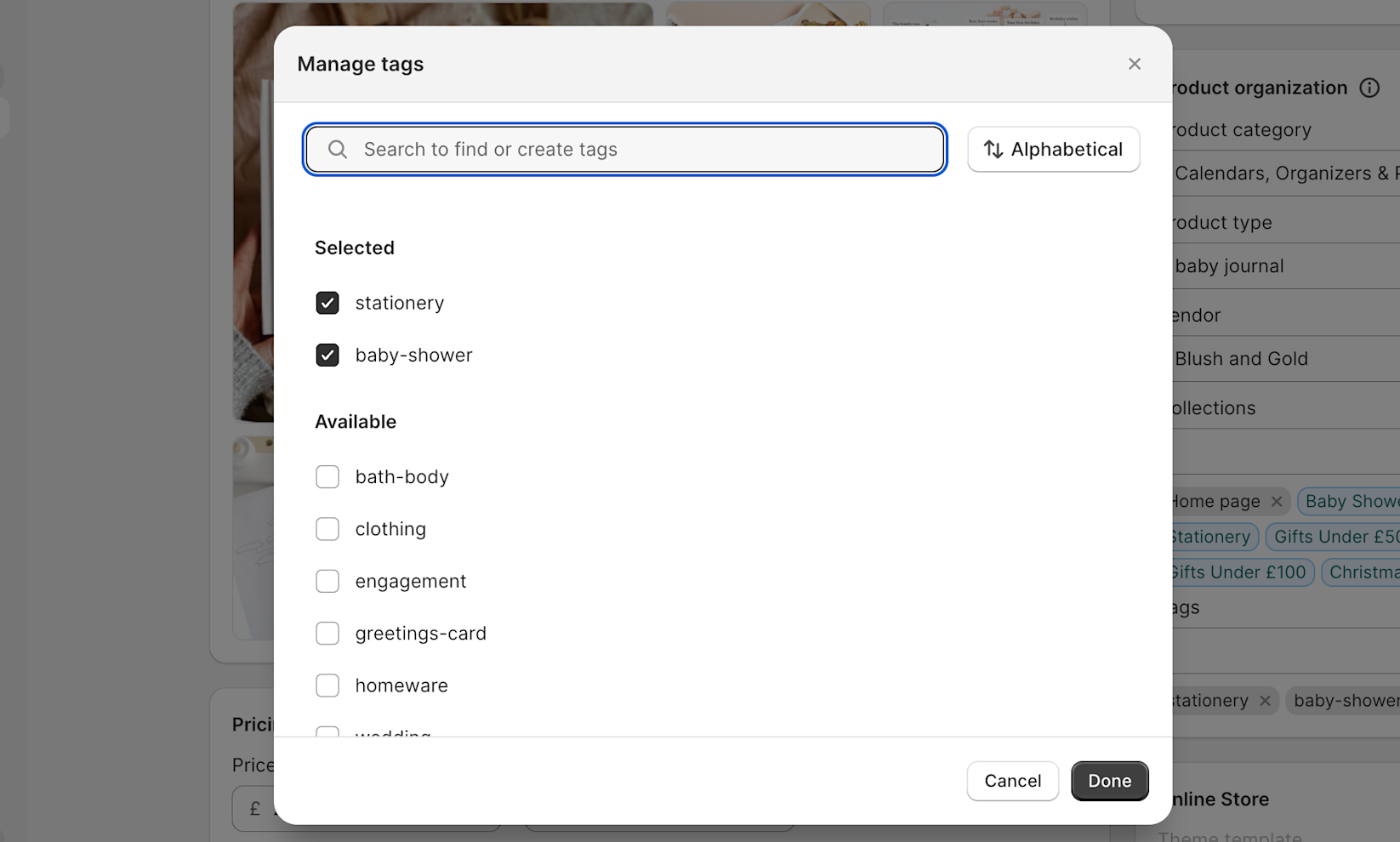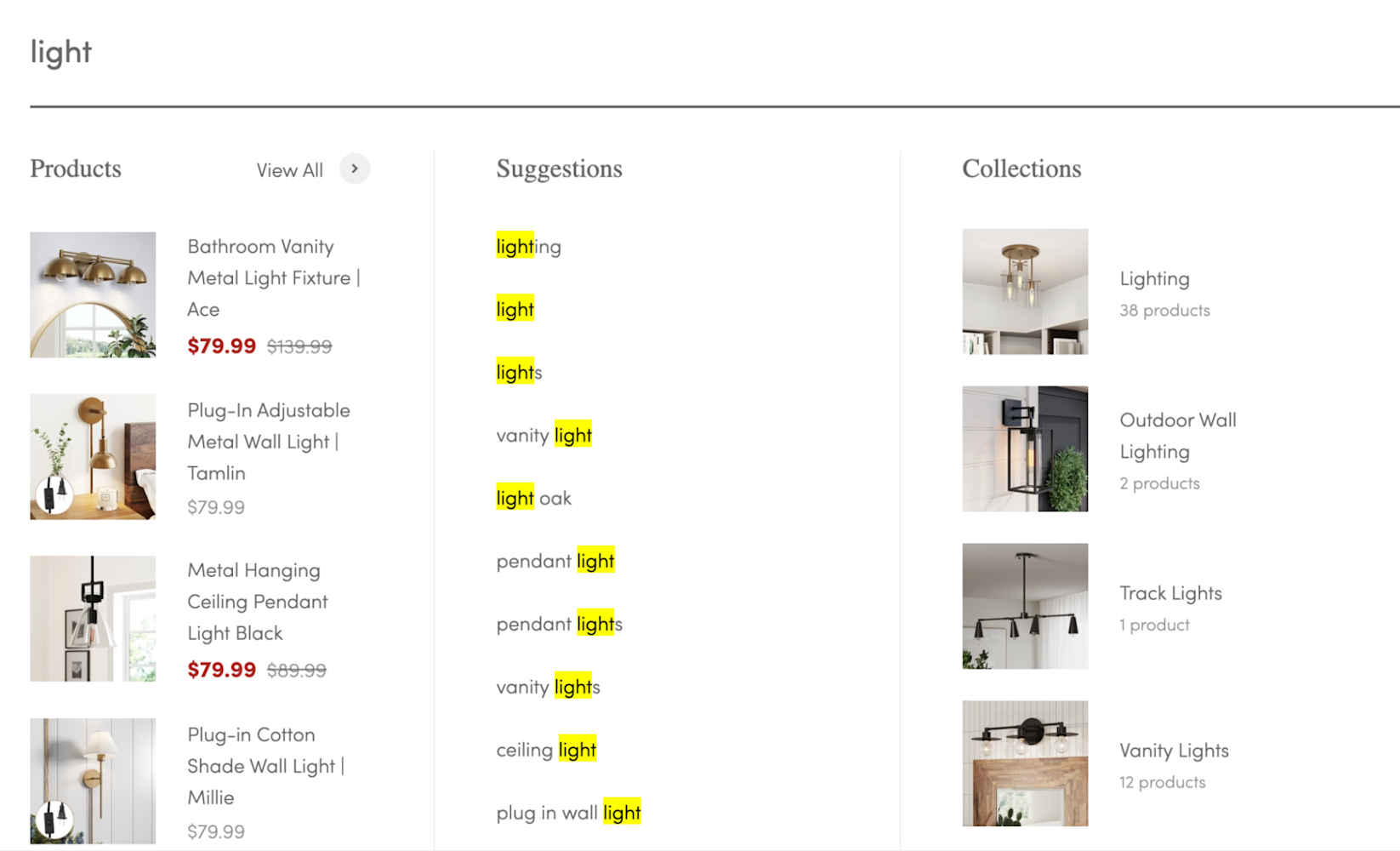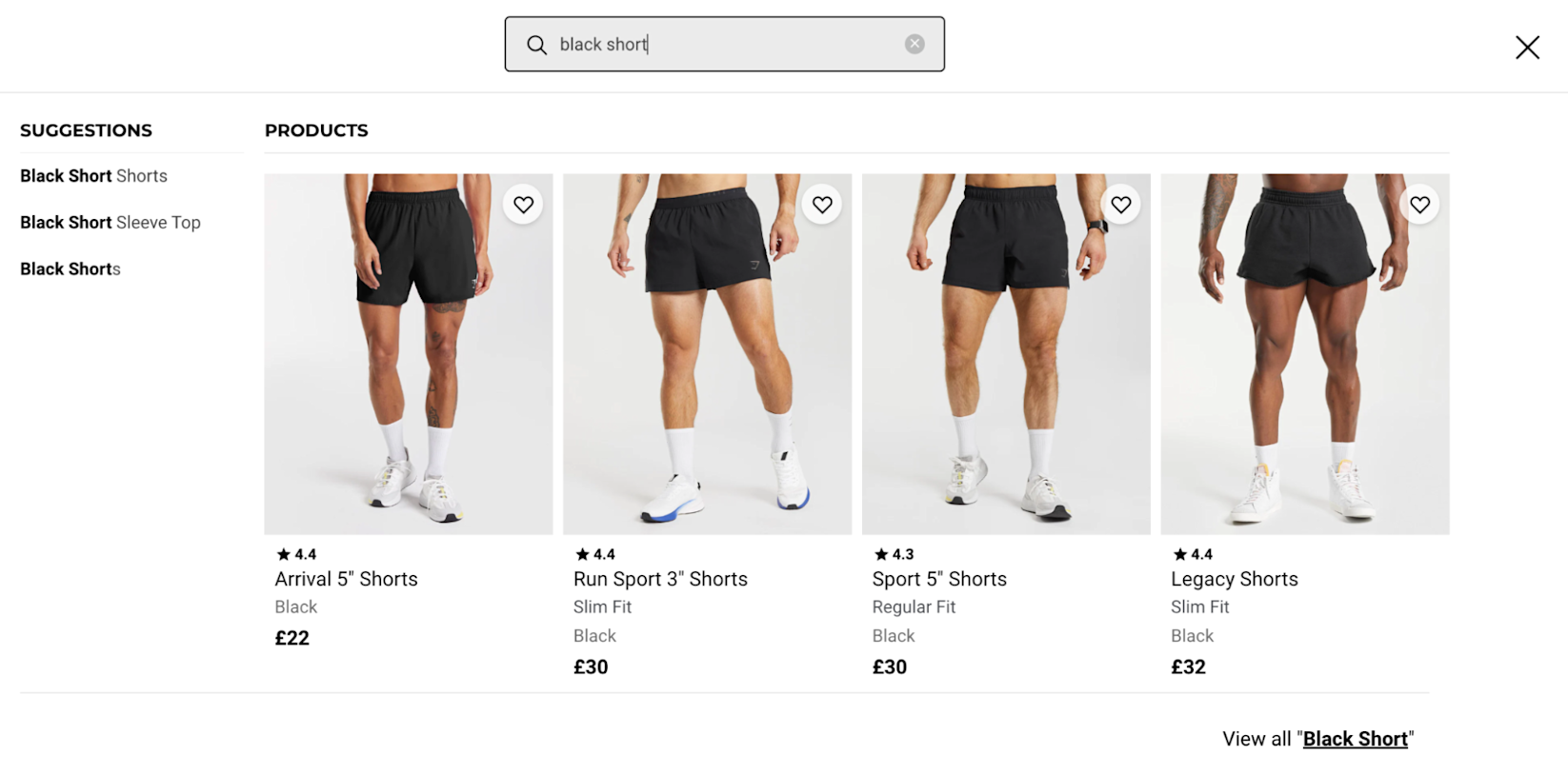Scaling ecommerce stores have thousands of SKUs. While categories and collections go a long way in making these products more discoverable, online shoppers still need to uncover the exact product type, variation, and price point that fits their purchase criteria.
Ecommerce site search makes that possible. It’s an internal search engine that retrieves the most relevant content—be that products or information pages—related to a shopper’s query. A seamless and intuitive search experience goes a long way in improving customer satisfaction, increasing sales, and reducing bounce rates.
This guide shares how to optimize your ecommerce site search, complete with guidance on how to choose a site search provider so you can improve ecommerce performance.
Table of contents:
- What is site search and how does it work?
- 12 best practices for setting up ecommerce site search
- Why is site search important for ecommerce?
- The benefits of using site search in your online store
- Choosing an ecommerce site search provider
- Reporting on your ecommerce site search
- Ecommerce search best practices FAQ
What is site search and how does it work?
An ecommerce site search solution is a third-party tool used onsite to sync customer search queries with product titles, variants, descriptions, images, videos, SKUs, and reordering codes.
It involves a search box where users can enter keywords or phrases, and a search algorithm that matches the query to relevant product pages on the website. The internal search engine connects these search terms with products and pages labeled in your ecommerce back end to provide personalized recommendations on demand and at scale.
“As a Shopify Plus merchant selling home furnishings, optimizing our site’s search is crucial—ecommerce product searches drive nearly 40% of online sales,” says Zach Dannett, co-founder ofTumble.“By fine-tuning search relevance, we make it effortless for customers to discover our most relevant items. The goal is to serve up products matching search terms and intent. With thousands of SKUs, nailing search is key to higher conversions.”
12 best practices for setting up ecommerce site search
- Ensure products are accurately named and tagged
- Provide a clear and prominent search box
- Use autocomplete to suggest popular search terms and products
- Use natural language processing to understand user intent
- Allow for misspellings and synonyms in search queries
- Use faceted search to allow users to filter results
- Add rich merchandising capabilities to site search functionality
- Prioritize search results based on relevance and popularity
- Use analytics to gain insights into user behavior and search trends
- Optimize search results for mobile devices
- Use A/B testing to continuously improve search performance
- Offer support for non-product searches
1. Ensure products are accurately named and tagged
Before any thought goes into optimizing your search engine, you need to ensure the back end of your website is configured to display accurate results.
“Our top technique for improving ecommerce search experiences is refining and expanding our product tagging strategy,” says Erin LaCkore, founder of jewelry brandLaCkore Couture.“Tags are critical for accurate search results, so we’ve put significant effort into ensuring every product is well-tagged with relevant, searchable terms.”
After restructuring its tagging approach, LaCkore Couture saw a 15% increase in search-driven conversions. This shows that strategic improvements can yield substantial results even within the default search function.

Shopify merchants can easily add, change, and customize tags on their product listing.
理查德·奥康纳的垫子也建议使用search analytics to discover the terms your target audience is actively searching for. This will allow you to learn the language and phrases people use for your products.
“For example, if your store sells men’s shoes, you may find that users search for loafers, brogues, and other specific shoe types,” says Richard. “Make sure you’re using these terms on the relevant products in your store to ensure that customers find them when using the search function.”
2. Provide a clear and prominent search box
The search bar on your ecommerce store is amongst one of the most interacted-with elements. Studies show69% of consumersgo straight to the search box when they visit an online store. This figure may be higher forreturning visitors他无法找到他们想要的项目buy in a previous shopping session.
Simplify the user experience by making the search box prominent on both desktop and mobile versions of your online store. That might mean:
- Using a sticky header containing a search box that’s easily accessible wherever a shopper is on the page
- Displaying a search icon in yourecommerce navigationbar
- Incorporating a secondary search box in your website footer

Both desktop and mobile users can easily find Spanx’s site search function.
3. Use autocomplete to suggest popular search terms and products
Being able to handle errors without manual interception is another key requirement for a third-party site search solution, which is often aided by natural language processing (NLP) and machine learning features.
Homeware brandNathan James, for example, offers search suggestions for each query. A search for “light” displays a list of product recommendations and collections alongside related terms like “vanity light” and “pendant lights.”

Nathan James’ internal search suggests related terms.
When mirror brandInyouthsimplemented its machine-learning-powered search autocomplete feature, it helped reduce its bounce rate by 23% and improve its conversion rate by 17% over a six-month period.
“It also increased the average session duration and the number of pages visitors viewed per session,” says Inyouths co-founder Kevin Wang.
4. Use natural language processing to understand user intent
The demand for natural language processing (NLP) within search has increased, allowing for accurate results even when the user can’t describe what they’re looking for. Adopted by the likes of Google, NLP-based search is part of ecommerce, driving real change in onlinecustomer experience.
NLP algorithms are based on context and relevance, rather than the presence or absence of keywords in product names or descriptions.
For example, NLP understands that a visitor who types in “red jumper” is happy to look at sweaters and pullovers, even though the query doesn’t contain the term “jumper.” The same applies to color and being able to understand variations of red.

Boll & Branch display products with related terms in its site search results for “cream quilt cover.”
5. Allow for misspellings and synonyms in search queries
High-converting ecommerce customer experiences are accessible. Not all shoppers, including the5% to 10% of the world’s populationwho have dyslexia, have the ability to accurately spell your product’s name or description. Of those who can, it’s uncommon to delete an incorrectly spelled word and initiate another search. Those are seconds a modern shopper can’t afford to waste.
Cater to these people by allowing them to make spelling mistakes in their site search. Choose a provider that can recognize commonly misspelled words and synonyms. That way, shoppers still see relevant results, even if their original query isn’t accurate.

Baby brandMoridisplays sleepsuits for the incorrectly spelled “sleepsuif.”
6. Use faceted search to allow users to filter results
Faceted search, also known as smart filters, help customers narrow down search results even further. They help retain those27% of consumerswho have left a site because the search results showed too many options.
“One technique we’ve implemented to improve ecommerce search experiences is changing the results page layout to include more filters such as product type, color, size, etc.,” says Ricky Allen, marketing director atEver Wallpaper.“这帮助客户缩小他们的选择和find what they’re looking for faster. Our conversion rate increased by 12% after implementing this change, and the customer feedback has been overwhelmingly positive.”

Ever Wallpaper allows shoppers who search for “floral” to filter their results by price and color.
7. Add rich merchandising capabilities to site search solutions
Many merchants look for a third-party search engine because their current setup lacks merchandising features, like a way to change the ordering of products in search results and the ability to feature user-generated content.
This is a huge disadvantage, especially considering more thanhalfof online shoppers are likely to engage with user-generated content—such as images, reviews, and videos—if it is shown in relevant search results. The same report found 54% of shoppers are likely to buy products after consuming this type of content.
This example fromLuvme Hairshows a rich instant search interface which displays various product attributes such as:
- Thumbnails
- Product reviews
- Sale prices and discounts

Luvme Hair’s search results are complete with each product’s price and review rating.
Suggested categories can also be displayed in the quick search interface, as well as non-product search results, such as customer service pages, blog posts, size guides, or even recipe ideas. Some site search engines show the full result set in the dropdown, with scrolling and faceted search filters.
The features that are important in this area include the ability to:
- Assign hero SKUs across specific queries and groups of queries
- Visual merchandise specific queries and groups of queries
- Create rules for boosting a specific selection of products (across individual queries and groups of queries)
- Handle variant-specific queries
- Include product labels
- Include attribute-based (tags and meta field) filtering in the quick-search interface and on the search results page
- Add recommended results to zero-result search errors
The payoff for this level of detail can be huge. Military collectables sellerInternational Military Antiquescredits InstantSearch+ for helping it create detailed search rules for more than 7,500 products with unique attributes like type, time period, and nationality.
The result was a 600% lift in conversions among visitors who use its onsite search.

International Military Antiques’ internal search function.
8. Prioritize search results based on relevance and popularity
Most enterprise-level retailers have adopted machine learning-based solutions, be it via onsite product recommendations, category merchandising, or onsite messaging and content.
Personalization is a new area that’s been introduced by a number of the different providers, which essentially promotes products based on individual user behavior. For example, after a user has been browsing men’s clothing onGymshark’s ecommerce websites, search results for “shorts” display men’s shorts.

Gymshark displays men’s shorts for this query, based on my viewing history.
The use of machine learning adds a second layer of accuracy, prioritizing products based on performance. It also ensures results are improved over time based on the learning from user behavior on the site.
What happens if your ecommerce site search doesn’t pull any products related to a potential customers’ search term? Don’t shortchange users with a “no products found” message. Instead, display products often bought by people searching similar terms.Almost a quarterof consumers think ecommerce merchants could improve their site search experience by offering alternative products when no exact matches are found.
9. Use analytics to gain insights into user behavior and search trends
电子商务商家可以使用搜索分析identify popular products, search terms, and trends. This information can be used to improve product offerings, website design, and marketing campaigns.
Important information to pay attention to includes:
- Query usage and search term counts
- Filtering usage and number of filters used
- Top performing queries (conversions)
- Top performing products (conversions and clicks)
- Under-performing queries (conversions)
- Where queries are being performed (pages)
- Where queries are being performed (geographically)
- Zero result queries
High volume search phrases that convert weakly are worthy of attention. They could indicate a problem with product inventory, or they could lead to new product offerings. These queries can also dictate merchandising decisions and actions. You could prioritize restocking items that are highly searched for but frequently out of stock.
Looking at where searches are being performed is another report to consider, as it usually highlights an issue with product or merchandising. For example, if shoppers browsing your stationery category often head to the search feature in their quest of finding a matching stationery set, make the product discovery journey easier by displaying sets together on the collection page.
10. Optimize search results for mobile devices
More people access the internet through smartphones and mobile devices than through desktop computers. By 2025, it’s estimatedmobile shopperswill account for 44.2% of all online sales. Ecommerce is critically dependent on a robust mobile strategy.
Experiment with using search as the primary user journey on mobile. A traditional menu-based navigation can be harder and slower to use on mobile where just aone-second delay in page load speedscan sabotage conversions.
Jewelry brandMoriaty’s Gem Artbenefited from making its mobile search bar more visible. The merchant attributes a considerable uplift inconversion rateson mobile to increasing search usage.
“We tracked our visitors through Google Analytics and saw that when people used our website’s internal search bar on their mobile device, the conversion rate was four times that of those who didn’t,” says Jeff Moriarty, digital marketing manager. “We immediately tested and moved it to be visible at the header of our website.
“The results were pretty incredible. For those visitors that had the mobile bar visible, we increased our conversion rate from 3.1% to 4.2%. Due to these results, we now have it visible 100% of the time.”

Moriarty’s Gem Art has a search icon in its mobile navigation bar.
11. Use A/B testing to continuously improve search performance
A / B测试比较searc的新变化h functionality against the original. Online shoppers who fall in the variant group interact with the new feature. You’ll collect data about how these people interact with the search function compared to your control group.
You can A/B test several elements of the search functionality, from displaying customer reviews in the results page to expanding the pool of products for a zero-result query. Be sure to limit the changes to one per test. If too many things differ between the control and variant groups, you can’t accurately attribute the result to a single change.
Natalie Thomas, director of conversion rate optimization and UX strategy atThe Good, recommends testing an instructional search prompt. That’s because instructional search encourages intentional browsing, improves UX, and boosts conversions.
“During research for one client, user tests and session recordings revealed that customers primarily navigate through the search bar,” Natalie says. “We also found that customers only engage with select menu categories. Our team hypothesized that adding friendly microcopy and enhancing search bar visibility would encourage the use of search and in turn, increase transactions.”
Natalie says the team put this to the test enhancing the search bar visibility with a white background and updating the language to “Try [search term].”
“It delivered over $3 million in revenue gains” says Natalie.
12. Offer support for non-product searches
Not everyone using an ecommerce search feature is looking for products. According toBaymard’s usability testing study, more than a third of online shoppers used a retailer’s search box to discover non-product information such as:
- About Us page
- Shipping information
- Returns policy
- Order cancellation
- Size guides
- Unsubscribing from a subscription
The same study found 39% of ecommerce sites don’t fully support non-product searches. Incorporating this functionality into your site search is not only a competitive advantage, but a helping hand to customers who are using search to learn about your company.

Clothing store Easy Standard retrieves its returns, refund, and gift card policies for the search term “returns.”
Why is site search important for ecommerce?
Site search engines matter in ecommerce because it helps customers find products quickly and easily, leading to increased conversions and sales, and provides insights into customer behavior. It connects the dots between what customers are actively looking to buy and the products they find on your ecommerce site.
Retailers have an opportunity to drive more revenue through search, especially for those who haven’t spent time optimizing this area.More than three-quartersof consumers agree that a good, fast, and accurate site search makes online shopping easier.
At the opposite end of the spectrum, there’s no better way to frustrate and disappoint customers than serving up irrelevant results—or even zero results for straightforward queries.
The benefits of using site search in your online store
Amongst the many benefits of offering an ecommerce search function on your online store include:
Improved user experience
Site search helps customers find products quickly and easily, improving the overallecommerce user experience.Research byNostofound 80% of consumers have exited a site after interacting with a poorly performing search function.
Increased conversions and sales
Customers who use site search are more likely to convert and make a purchase. The same report found 79% of consumers are likely to buy a product they’d searched for using a merchant’s site search feature.
Valuable insights into customer behavior
Site search data provides insights into what customers are searching for and what products are popular. Use this information to make inventory and marketing decisions.
Personalization
Site search can be personalized to show relevant products based on a customer’s search history or preferences. This impacts revenue.Studies showseven in 10 consumers are likely to complete a purchase if the results are personalized to their purchase history.
Higher average order value
Richard O’Connor, strategic marketing director ofFirst Mats, finds search can indicate a high-intent shopper.
“For our store, only around 2% of our visitors use the search function,” says Richard. “But those who do are over 500% more likely to convert than those who don’t use search, and they spend 600% more per user too.”
Competitive advantage
A good site search can give businesses a competitive advantage by providing a better user experience and driving more sales.
“From my own experience with sites in the enterprise space, I’ve found the average conversion rate increases to be closer to 3.5 times non-search visitors, with around 5% to 10% of visitors using search,” says Paul Rogers, co-founder of ecommerce consultancyVervaunt.
Choosing an ecommerce site search provider
Ecommerce search has become mainstream in recent years. Options exist for merchants of all sizes, with enterprise-level solutions available from as little as $200 per month. This availability has driven a surge in popularity and usage.
Simplify the decision-making process by evaluating ecommerce site search solutions based on the following criteria:
Features
Essential features for an ecommerce site search vary from business to business. Growing organizations are more likely to need natural language processing and machine learning features from internal search engine providers.
Integrations
Confirm the solution on your shortlist is compatible with your existing ecommerce toolstack. This includes your ecommerce platform, API clients, and customer profiling software.
Customization
The more customization features, the greater your ability to provide unique online experiences. Site search tools that allow you to customize the functionality are more likely to grow with you as your online store scales, reducing the need to switch to another platform later down the line.
Performance
With site search being such an important element of your site, you can’t afford to disrupt customer experiences if the platform goes down. Check each provider’s uptime report and confirm there are plans in place to keep the functionality available if an unexpected problem occurs.
Pricing
Apps likeSearch and Discoveryare free, though premium internal search engines come with a monthly subscription cost. To reduce the likelihood of switching providers, make sure your current selection is affordable.
With so many third-party providers vying for business in the enterprise market, start by comparing Shopify Plus technology partners likeKlevu,Algolia, andFindifythat specialize in ecommerce site search.
Home furnishing brand Tumble leverages Shopify’sSearch and Discoveryfunctionality to power its website.
“The seamless integration, ongoing enhancements, customization, scalability, and cost-effectiveness make Shopify search a great fit,” says Tumble co-founder Zach Dannett. “We can optimize keywords, tags, and titles to uncover high-value terms and enhance discovery. The payoff is a personalized, streamlined search experience that fuels customer satisfaction and sales.
“We also leverage artificial intelligence like Shopify’s Keyword Manager to uncover high-value search terms,” Zach says. “Descriptive product titles and tags further optimize discovery. The payoff is that customers can easily find and buy what they’re looking for in just a few clicks.”
Reporting on your ecommerce site search
For many merchants, the search bar is underutilized and often neglected in favor of new, shiny design elements. The opposite is true for online shoppers who flock to the search bar to speed up their product discovery journey.
Use the ecommerce search best practices outlined here to connect shoppers with the products they’re actively searching for. Whether you’re using NLP to understand user intent or rich merchandising features to showcase each SKU in its best light, merchants that optimize their ecommerce search experiences are one step closer toincreasing their site’s conversion rate.
卖给你的客户tomers shop
Only Shopify POS unifies online and in-store sales and makes checkout seamless. Get all the tools you need to break free from the counter and sell wherever your customers are without worrying about your tech stack, integrations, or fragmented reports.
Ecommerce search best practices FAQ
How can I improve my ecommerce search?
- Make the search bar clear and prominent.
- Allow for misspelled words and synonyms.
- Use autocomplete to predict search queries.
- Display rich merchandising features in the search results.
- Prioritize results based on relevance and popularity.
- Use A/B testing to improve search performance.
How does ecommerce search work?
An ecommerce search engine works by comparing a user’s query against information stored in each product listing. If a fashion shopper is searching for green shoes, for example, the site search functionality would browse the merchant’s product catalog for SKUs matching either term.
What are the different types of searches in ecommerce?
- Exact search, which spell the product name exactly
- Product type search, which define the category of a product
- Non-product searches, which don’t contain product-specific information
- Symptom searches, which detail the pain point a shopper has
Read More
- A Crisis Communications Plan for Brands
- Ecommerce Agency Automation: Saving Time, Selling More & Launching Faster
- The Seven Signs Your Supply Chain Is Hemorrhaging Money & How to Fix It
- 直接向消费者vs批发:客户的雄厚ce Over Competition
- Hypefest 2018: O2O Examples from the Forefront of Marketing & Retail
- 5 Easy Tips For Getting Started With Conversion Rate Optimization
- Wholesale Ecommerce: What is It and How to Start?
- How to Avoid the Hidden Cost of Black Friday, Cyber Monday Sales and Increase Customer Lifetime Value through Personalized Email
- ‘Emotional Ecommerce’ Increases Repeat Purchases 80%, Retention 58%
- Ecommerce Site Search Best Practices: How to Sell More to the People Who Want to Buy Now






